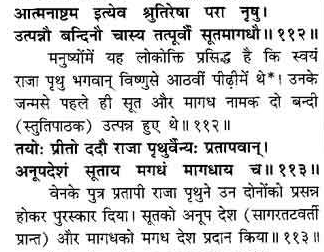According to the Mahabharata, the origin of Sutas can be traced back to the time before the legendary King Prithu. Bhishma Pitamah reveals to Yudhishthir that two bards, Suta and Magadha, emerged and became rulers of the Anupa (Anga) region and Magadha region, respectively.

Another definition states that a child born to a Kshatriya father and Brahmin mother is referred to as a Suta. In this context, Yadu, the founder of the Yadu dynasty and an ancestor of Lord Krishna, was probably the first prominent Suta, being the son of King Yayati (Kshatriya) and Devayani (Brahmin).
Respected Professions
Sutas primarily worked as storytellers or charioteers, both highly respected and crucial professions. Most Brahmins were well-versed in storytelling, while Kshatriyas trained as charioteers. Renowned storytellers like Lomaharshan and his son Ugrashrava commanded great respect.
Moreover, celebrated warriors like Lord Krishna and Shalya served as charioteers. Charioteers typically shared a close bond with warriors, acting as friends and advisors. For instance, Sanjay was Dhritarashtra’s charioteer and referred to as his friend and counselor. Karna’s adoptive father, Adhiratha, was a close friend of Dhritarashtra.
Diverse Roles
Sutas were not restricted to these professions alone; they pursued various roles. Karna’s uncle was the king of Anga, while Kichaka served as the general of Matsya’s army. Karna himself was an accomplished warrior and later became the king of Anga.
When someone was called “Sutaputra,” it merely indicated their lineage, not used as a derogatory term.
Acceptance by Pandavas
The Pandavas did not discriminate against Sutas. Abhimanyu’s wife, Uttara, was the daughter of Sudeshna, who belonged to the Suta lineage. The Pandavas wholeheartedly accepted her as their daughter-in-law, showing no prejudice.
No Evidence of Discrimination
Contrary to the narrative that Karna faced discrimination due to his Suta lineage, the evidence from the Mahabharata does not support this claim. The text does not mention Sutas being part of a low caste or facing discrimination from upper castes.
Instead, Sutas held respected positions in society, pursuing diverse professions and roles, including storytelling, chariot driving, kingship, and military leadership. The Pandavas, themselves, embraced a Suta woman into their family, indicating an absence of prejudice against this community.
The evidence from the Mahabharata portrays the Sutas as a respected community, pursuing esteemed professions and holding influential positions in society. Instead, the history presents a more nuanced and inclusive view of the Suta community’s standing in ancient Indian society.


